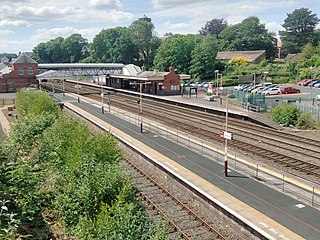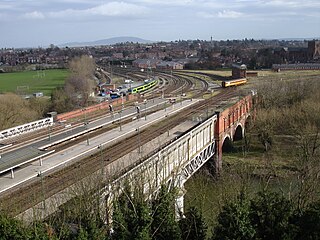Related Research Articles

The English county of Shropshire has a fairly large railway network, with 19 National Rail stations on various national lines; there are also a small number of heritage and freight lines, including the famous heritage Severn Valley Railway running along its eastern border with Worcestershire.

The Welsh Marches line, known historically as the North and West Route, is a railway line running from Newport in south-east Wales to Shrewsbury in the West Midlands region of England. It follows a route by way of Abergavenny, Hereford and Craven Arms and thence, by some definitions, to Crewe via Whitchurch. The line thus links the south of Wales to north-west England, via the Welsh Marches region, bypassing Birmingham.

The Wolverhampton–Shrewsbury line is the railway line from Wolverhampton to Shrewsbury via Wellington; it was originally built by the Shrewsbury and Birmingham Railway. The line is double track throughout, with rarely used relief sidings at Cosford and four tracks through Wellington station.

Shrewsbury railway station serves the town of Shrewsbury, in Shropshire, England. Built in 1848, it was designated a grade II listed building in 1969. Many services starting at or passing through the station are bound for Wales, and it is a key hub for its operator, Transport for Wales; services are also provided by West Midlands Railway.

The Shrewsbury and Birmingham Railway was authorised in 1846. It agreed to joint construction with others of the costly Wolverhampton to Birmingham section, the so-called Stour Valley Line. This work was dominated by the hostile London and North Western Railway, which used underhand and coercive tactics. The section between Shrewsbury and Wellington was also built jointly, in this case with the Shropshire Union Railway.

Wellington railway station serves the town of Wellington, Shropshire, England. It is situated on the former Great Western Railway's London Paddington to Birkenhead via Birmingham Snow Hill line. Trains are operated by West Midlands Railway, and Transport for Wales.

Telford Central railway station serves the town of Telford, Shropshire, England. It is located on the Wolverhampton to Shrewsbury Line and is operated by West Midlands Trains. It is situated close to the Telford Shopping Centre, the main commercial district of the town.

Oakengates railway station serves the town of Oakengates, Telford and Wrekin, Shropshire, England. It has two platforms.

Shifnal railway station is a railway station which serves the town of Shifnal in Shropshire, England. The station is managed by West Midlands Trains, who provide the majority of services that call here.

Cosford railway station is a railway station which serves the village of Cosford in Shropshire, England. It also serves RAF Cosford which is also home to a branch of the Royal Air Force Museum. The station is served by West Midlands Trains, who manage the station, and Transport for Wales. Between 2008 and 2011 it was also served by the direct London operator, Wrexham & Shropshire.

Albrighton railway station is a railway station which serves the village of Albrighton in Shropshire, England. The former up goods yard is now occupied by a small estate of low rise offices.

Severn Bridge Junction is the area of railway lines just south east of Shrewsbury railway station, in Shropshire, England. It is controlled by a mechanical interlocked signal box of the same name, which is the largest operational mechanical signal box in the world. The Network Rail signalling area code is 'SBJ.'

The Shrewsbury and Wellington Joint Railway (S&WJR) was operated by the London North Western Railway and the Great Western Railway. Its line ran from Shrewsbury to Wellington. Abbey Foregate also acted as a junction, with chords to Shrewsbury station and to the direct line to Wales.
Abbey Foregate railway station was in Shrewsbury, Shropshire, south-east of Shrewsbury station, to the east of Severn Bridge Junction, on what is today the Shrewsbury to Wolverhampton Line. Despite its name, the nearest road was Underdale Road, not Abbey Foregate.
Admaston railway station was a railway station serving the village of Admaston in Shropshire, England. It was located on what is now known as the Shrewsbury to Wolverhampton Line.

Newport (Shropshire) station was a railway station serving Newport in Shropshire. that was situated on the Stafford to Shrewsbury Line via Wellington.
The Stafford–Shrewsbury line is a former railway line in England, which ran between Stafford in Staffordshire and Shrewsbury in Shropshire, via Newport and Wellington, from 1849 to 1966. The Shropshire Union Railways and Canal Company (SUR&CC) constructed and ran one of the few railways in England ever built by a canal company. The line served Newport and Wellington stations. The SUR&CC were solely responsible for the section from Stafford to Wellington; but the building and operation of the 10.5 mile (17 km)-long Shrewsbury-to-Wellington section was shared with the Shrewsbury and Birmingham Railway.

Allscott is a small village 3 miles (4.8 km) north west of Wellington, Shropshire. The River Tern flows by. It falls within the parish of Wrockwardine and the borough of Telford and Wrekin. Nearby is the small village of Walcot.
Upton Magna railway station was a station in Upton Magna, Shropshire, England.
Stafford Road railway station served the city of Wolverhampton, historically then in Staffordshire, England from 1850 to 1852 on the Wolverhampton-Shrewsbury line.